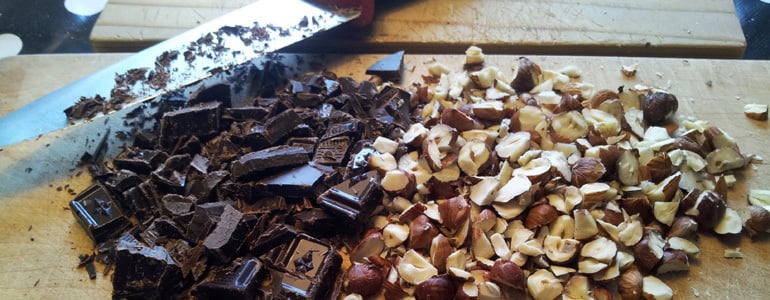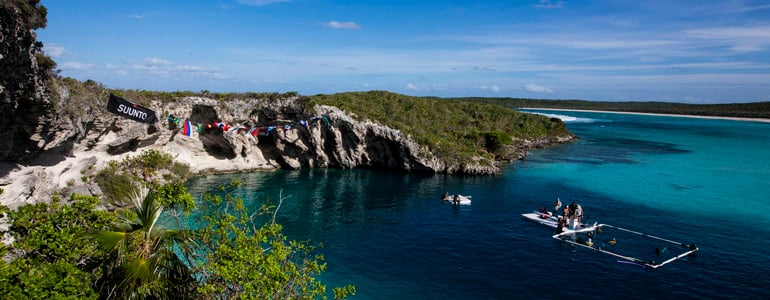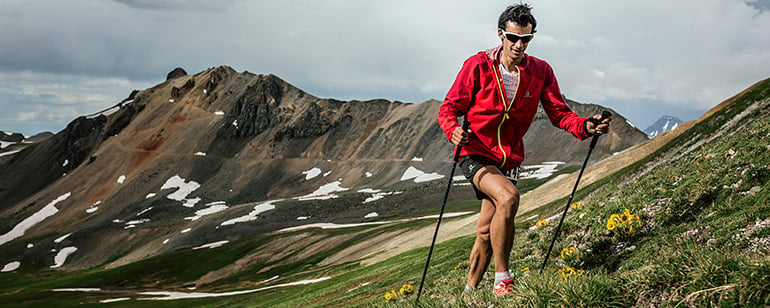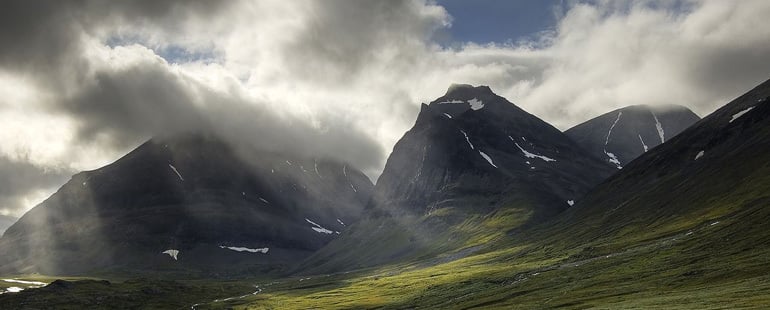

SUUNTOブログ

Emelie's favorite cookie recipe
When it comes to the best food for runners, nothing quite beats homemade treats, says Emelie Forsberg. “I love to bake,” says the Swedish trail running sensation. Here's her favorite cookie recipe. If it's good enough for her...
100 grams butter (I prefer butter when I´m in the north, just because I love the feeling of trying to eat what we can find here)
0.25 liter of flour (whatever you prefer, I use coconut and wheat)
0.2 liter of oats
2 spoons of raw sugar (take a little more or less, all depending what you think tastes good!)
100 grams of dark chocolate
0.5 dl hazelnuts
1 table spoon of baking soda
Warm the butter a little until it softens, not melts completely.
Chop the chocolate and the hazelnuts, stir everything together.
Put them in the oven for 15-17 minutes at 175° C.

Dive into the world of a freediver
Will Trubridge has broken numerous freediving records but below, he reveals why he dives for the sense of exploration. Are you training for anything special? The fall is always the period of the year when I try and peak my training, so if everything has been going well over the summer then I will try to focus my efforts on one of the disciplines and see where I can get to. Is Molchanov's CWT record breakable? Every record is breakable! I worked hard on my CWT technique between 2012-2013, and I had an attempt in 2012 at the world record which failed by a whisker –forgetting to remove my nose clip on the surface. That dive was 125 m, and the record is now 128 m, so it is now an even bigger challenge, but not out of reach. My speciality has always been the no-fins discipline though, and it is also the one I enjoy the most. This year I'm concentrating more of my energy there.
Remind us why you freedive and what the sport means to you.I do it mostly for the sense of exploration and the challenge. By diving deeper than the human body has ever been we are redefining our limits as a species, and it is exciting to be on this frontier. I'm also the kind of person who needs to be challenged, mentally and physically, and freediving is a sport that supplies both.
Beyond both these answers, the sensation of merging with the water, and sinking deeper into a place where sounds, light, and all other stimuli are muted is an other-world experience that I am blessed to be able to enjoy.It must be tough having to train in all these locations like the Caribbean, Honduras...Tell me about it. I often long for a cold drizzle or snowfall... not! In fact I try not to forget that being able to combine a passion with a career and to be able to travel to all these magnificent places and dive in them is a dream. I'm grateful for every day and every second underwater.
It seems freedivers must lead very pure lives. Do you have any vices? I get so much fulfillment and nourishment from what I do that I really don't feel the need for anything more, especially something that comes at a price, like a vice does! However, could you call drinking hot sauce from the bottle a vice?Looking ahead, where do you think the sport is headed? Is it going to get more popular?Yes, I think it is. Some say our generation is living in an environmental and spiritual revolution, and freediving is a sport that ties in well with both those ideas. It simultaneously brings you back into touch with yourself and the environment in a way few other performance sports do. It is also the only truly aquatic (immersed) sport, so it offers an experience that is unparalleled in any other activity. A lot of people are discovering this, and finding a rewarding sport that leaves a light impression on our planet while drawing us closer to it and ourselves.Main image and portrait ©Samo Vidic. Underwater image ©Agustin Munoz

Another record falls to the king of speed
Keeping up with Kilian Jornet is a full time job for his fans this summer. Less than a month after ascending north America's highest mountain Denali in record time the trail-running, speed-ascending legend has smashed another record – this time the Hardrock 100 ultra run. It's one of the world's toughest ultras and the most famous in America. But help is at hand. Thanks to the new connected capabilities of the Ambit3, it's possible to relive and share Kilian's epic feat, in which he knocked 42 minutes off the previous record to finish in a time of 22h 41m. The video below reveals just how fast he was running.
The Hardrock, a 160km race with a total climb of 20,722m, holds legendary status for ultra runners the world over and had been on Kilian's tick list since he was a teenager. “I’m thrilled for this result, this was the last race left from the list I made when I was 16. I’m very satisfied both for the victory and the record, but also because I’ve had very good feeling from the begining. It has been almost a perfect race,” said Kilian after the race.“The path is very beautiful, both for the track and the landscapes,” he added. It’s one of this races that I wouldn’t let any single part left, it was great to run here. The lowest point of the race is at 3.000m so it’s a very technical race in high height, which makes it special. Without even hesitate, this is one of the nicest races I’ve ever done.”
Thought this was epic? Prepare to be amazed by Kilian's record ascent of Denali.
Photo: ©Jordi Saragossa

Why take a dive computer?
It's one of the most important bits of diving gear you can take underwater. The Scuba Diver Girls explain why.
A dive computer is one of your most essential bits of gear and can keep you safe when your dive plan changes, says Margo Sanchez, president of Scuba Diver Girls.“I saw a hammerhead shark,” says Margo. She and her buddy Stephanie had been diving a wall in Papua New Guinea with Tufi Resort. Their plan had been to stay at around 25m (80 ft) – but then they spotted this beautiful hammerhead, which typically patrols deeper depths. “It is better to have a computer that will help you adjust on the fly.”Sanchez did not want to pass up this amazing opportunity to get closer to this majestic animal and swam deeper. Her Suunto D6i alerted her of the depth. She kept her eye on her wrist so she could monitor how long she could stay at her new deeper depth while she filmed the great hammerhead. “Even though I wanted to continue to follow that beautiful shark, I used my Suunto to gauge when it was time to begin my ascent to shallower waters.”“Manual gauges won’t be there to assist you with your dive profile when your dive strays from your plan, and you can really get yourself into trouble.”
Margo notes that many things can change your plan while diving, and it is better to have a computer that will help you adjust on the fly. “Three minutes can seem really long when you are just hanging out in the big blue.”Sanchez finds that the upgrade to a computer from manual gauges has further benefits. “It’s also a timer – it counts your safety stop down for you,” she says. “Three minutes can seem really long when you are just hanging out in the big blue with not much to do. The computer tells you when it is safe to make your ascent to the surface.” Dive computers also track your time out of the water, so you know the second that the pool is open again for a second dive. Says Sanchez: “You can figure your surface interval with dive tables, but it is much easier to push a button on your computer and see exactly when it’s time to dive again.”She also likes her dive computer for its accuracy. “Gauges often aren’t accurate – on a number of occasions my air pressure gauge has been off by as much as 300 psi.” She likes the air integration with the computer where she can see very accurately what her psi is during a dive. Finally, Margo notes that there are other features of her Suunto that she loves. “The ability to check the temperature when I am diving in Southern California is great. The water can get pretty cold and it is fun to see real time what the temperature is.”
Also she likes to be able to scroll through her dive profile after the dive and see air consumption throughout the profile. “It is fun to keep track of all the amazing places we have been, where we dove, and what we saw there. You don’t get that with manual gauges!”
Image: ©Larisa Steele

A Swedish crown for the queen of mountain running
In case anyone was hoping Emelie Forsberg might take it easy after being crowned the 2014 Skyrunning ultra world champion, they're going to disappointed. Fresh from her win at the Mt Blanc 80 km race, Emelie returned home to catch up with some friends. But then she thought going for a run up Kebnekaise, Sweden's highest mountain would be a fun addition to the itinerary.
It will surprise no one that she returned from the summit having broken the overall (men's) record.
“I didn't have it in mind to go for the record when I decided to go visit my friends,” she tells us. “But the idea came and so I took off. It's a super nice route with some scrambling and climbing and it was such a beautiful morning. It was so great to share the start and finish with my friends!”
“It feels pretty cool to have the overall record time – on Sweden´s highest mountain too!” she adds.
The route was 14 km and featured 1,400 m of ascent. The previous record was 2h 17m.
Top image shows the view of the Laddtjovagge valley, featuring Sinngitjokka, Tuolpagorni, Vierramvare and the foot of Kebnekaise. ©AlexandreBuisse
Running image from file: ©JordoCanameras

Pedaling to volcanic peaks
Brody Leven recently cycled from Portland, Oregon to Seattle, Washington, with the goal of climbing and skiing huge volcanoes that were 'on the way'. Surprisingly, he tells us the downhills were harder than the ascents...
What the idea behind this trip? The goal was for two college friends, who hadn't had an adventure together in years, to ride bikes from Portland to Seattle...the long, hard, and painful way – effectively tripling the typical route's distance – in order to climb and ski Mt. Adams, Mt. St. Helens, and Mt. Rainier, three huge Washington volcanoes. Personally, I wanted to combine two activities that I love, ski mountaineering and bike touring. We also wanted to remind ourselves that we don't need big budgets, helicopters, worldly knowledge, or even a passport to have a good, old-fashioned adventure. What bike were you riding? It's a hybrid cyclocross/touring bike – a triple-ring, aluminum frame, with a carbon fork, fenders, comfortable touring seat, racks, five panniers, and customized single-axle trailer. I've only ridden the bike three times in four years: solo across the United States in six weeks, around the coastline of Hawaii in two weeks, and now the hard way from Portland to Seattle in two weeks. I'd never put a trailer on it before this trip.How hard is it to cycle with all that gear? It isn't even like riding a bicycle. It feels as though you're riding something different, something other than a bike, some sort of vehicle. If you look over your shoulder and swerve, you're going in the ditch (which I learnt the hard way). You can't just throw your leg over the top and start peddling – instead, you need to do this weird running push-start. The weight made it incredibly difficult to ever get out of the granny gear.How much did it all weigh? 150-200 pounds (68 kg - 90 kg) without me. Weight fluctuated with water and food supplies.
How were the downhills?I wasn't comfortable enough to really get moving fast down hills until ten days into the trip, when I started to use my body as a sail to slow down. This is noteworthy because going downhill was often much more difficult than going uphill, since my brakes were almost worthless with that much weight moving the bike. You had to keep it perfectly upright in order for it not to fall over, and the trailer was constantly in danger of jack-knifing. Road or off-road? Maybe 75 miles (120 km) we biked were on loose dirt, gravel, or sandy roads. But they accounted for about 90% of the trip's overall effort, as they were often on the biggest hills.Did you have to push? Not uphill! But descending hills was so hard that I occasionally had to step off and walk my bike for a while, allowing my brakepads and rims to cool off (they were very hot to the touch, noisy, and ineffective). Even walking it down hills was difficult, because balancing it perfectly upright was essential or all of the weight would topple it over.
Click here to see Brody's 120km ride from Portland to Hood River – and here to see his ski tour on Mt Adams. Biggest challenge of the trip? Riding the 15-mile, 3,500-foot, dirt, gravel, and sand Mt. Adams approach road after biking 40 miles that morning was so hard. Also, not eating every cinnamon roll and huckleberry shake in a 400-mile radius tested my self-control! All images ©Brody Leven. Check out more of his adventures on Brodyleven.com














































































